
Area Sacra di Largo Argentina: holy site, murder scene and cat sanctuary
Area Sacra di Largo Argentina: holy site, murder scene and cat sanctuary
| Last updated: June 2023 |
Have you visited Rome before? If so, chances are you've stumbled upon the Area Sacra di Largo Argentina (Google Maps) at some point. This intriguing square, a mere stone's throw away from the Pantheon, lies several meters below the present street level and holds the remains of four Roman temples (the Area Sacra). Doesn't ring a bell? Then perhaps you remember Rome's famous Cat Sanctuary and the sight of dozens of stray cats that have made the area their home.

Street-level perspective of the sacred area, showcasing the remains of Temples A and B in the foreground.
It may not sound very exciting, yet the Area Sacra di Largo Argentinais said to be one of Rome's most important archaeological sites. However, despite its historical significance, the sacred area has long been off-limits, allowing curious visitors only a street-level view. Until now (June 2023)!
Over the past couple of months, walkways have been installed, allowing the public to tour the ruins for the very first time. I was lucky to be in Rome and visited the Area Sacra di Largo Argentina right after the opening.
Before telling you about what's there to see, let's briefly delve into the history of this remarkable area.
Another street level view of the Area Sacra di Largo Argentina (left) and one of the Rome's stray cats caught sunbathing on the steps belonging to Temple A (right).
Campus Martius
The Area Sacra di Largo Argentina now sits in one of Rome's most vibrant districts, a stark contrast to its early Roman past. In those times, the site was part of a vast floodplain known as the Campus Martius. This stretch of land, located just outside the Servian Walls and the sacred boundary of the pomerium (Rome's sacred boundary), lay between the Tiber River and the slopes of the Quirinal, Pincian, and Capitoline hills. The name 'Campus Martius' means 'Field of Mars,' as the area was dedicated to Mars, the Roman god of war and protector of agriculture. Aside from a small altar honoring Mars, the land was mostly empty, used primarily for military drills and grain cultivation.
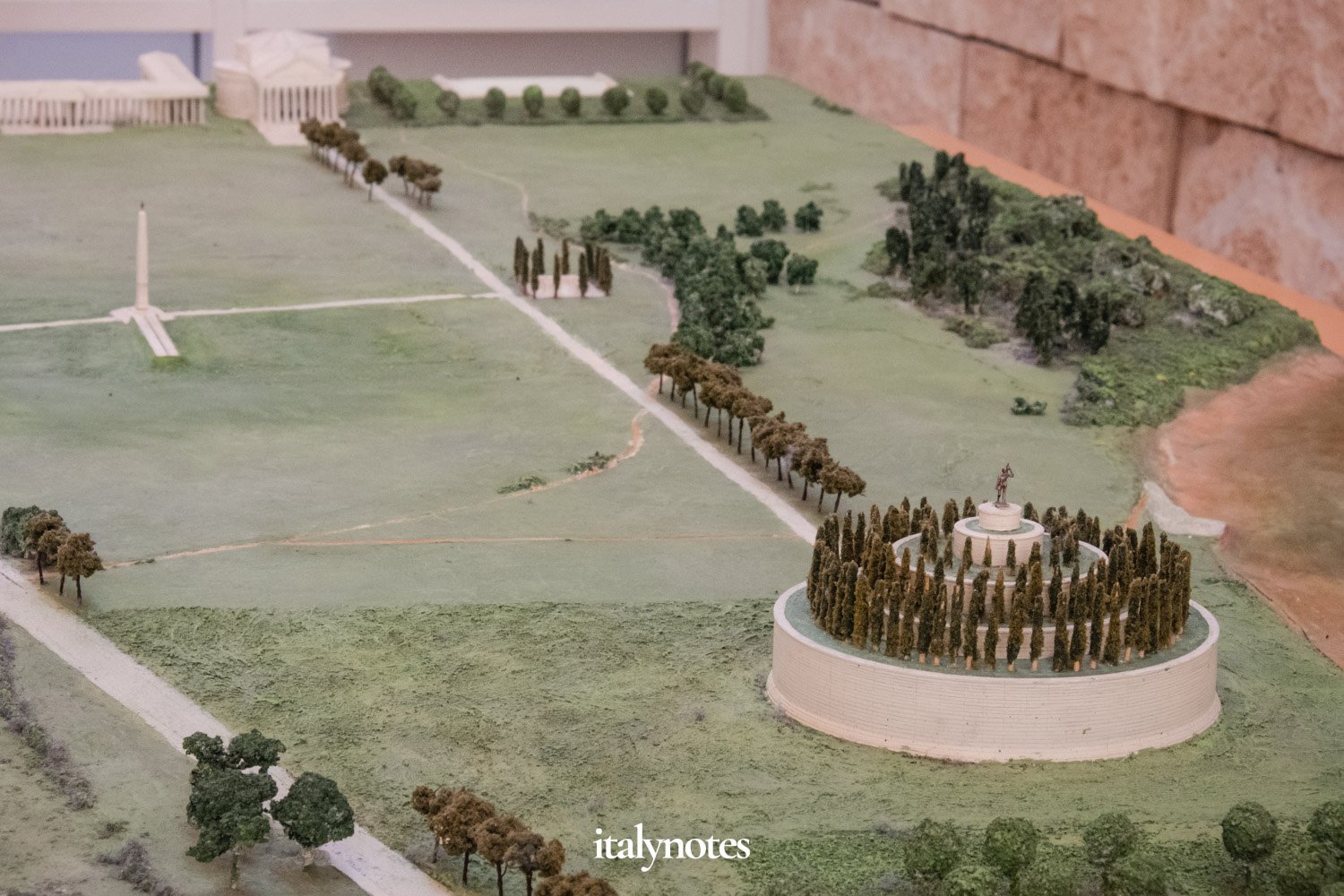
Model of part of the Campus Martius in de first century AD. In the foreground is the circular Mausoleum of Augustus. A long street connected to Mausoleum with the Pantheon (seen in de background).
From the 4th century onwards, Roman military conquests began to expand beyond the Italian peninsula. This increased number of foreign wars brought significant wealth into Rome. Part of it was used by triumphant generals to erect temples in honor of the deities to whom they dedicated their victories. Many of these temples were built on Campus Martius.
Besides temples, various public buildings, such as theaters and stadiums, were constructed, gradually transforming Campus Martius into a bustling urban center. Some of these monuments are still (partially) visible today, such as the Pantheon, the Ara Pacis, and the Stadium of Domitianus (now buried underneath Piazza Navona).

The Pantheon is the most notable and best-preserved monument of the Campus Martius yet extant.
In the 3rd century AD, the power of Rome started to weaken, and Campus Martius rapidly began to change. Around the 4th century, many old temples were neglected, demolished, or sometimes transformed into Christian churches. The following century was even more devastating as Rome was burned and sacked twice (by the Visigoths and the Vandals). On top of that, the city had to endure three earthquakes and two floods that washed over the lower-lying areas. Halfway through the Middle Ages, little was left of the Roman Campius Martius, as many ruined monuments served as mere foundations for new houses.
Discovery of the Area Sacra
After the Italian unification in 1861, it was decided to reconstruct part of Rome. This led to the demolishing of medieval houses around Torre Argentina to make space for the construction of new buildings. However, during the demolition of the old neighborhood, the colossal head, arm, and foot of a marble statue were discovered. Further excavations brought to light one of the most important archeological complexes in Campus Martius: a large paved holy area dating back to the Roman Republic. It housed four ancient temples and part of the Curia Pompeia. We now know this site as the Area Sacra di Largo Argentina.
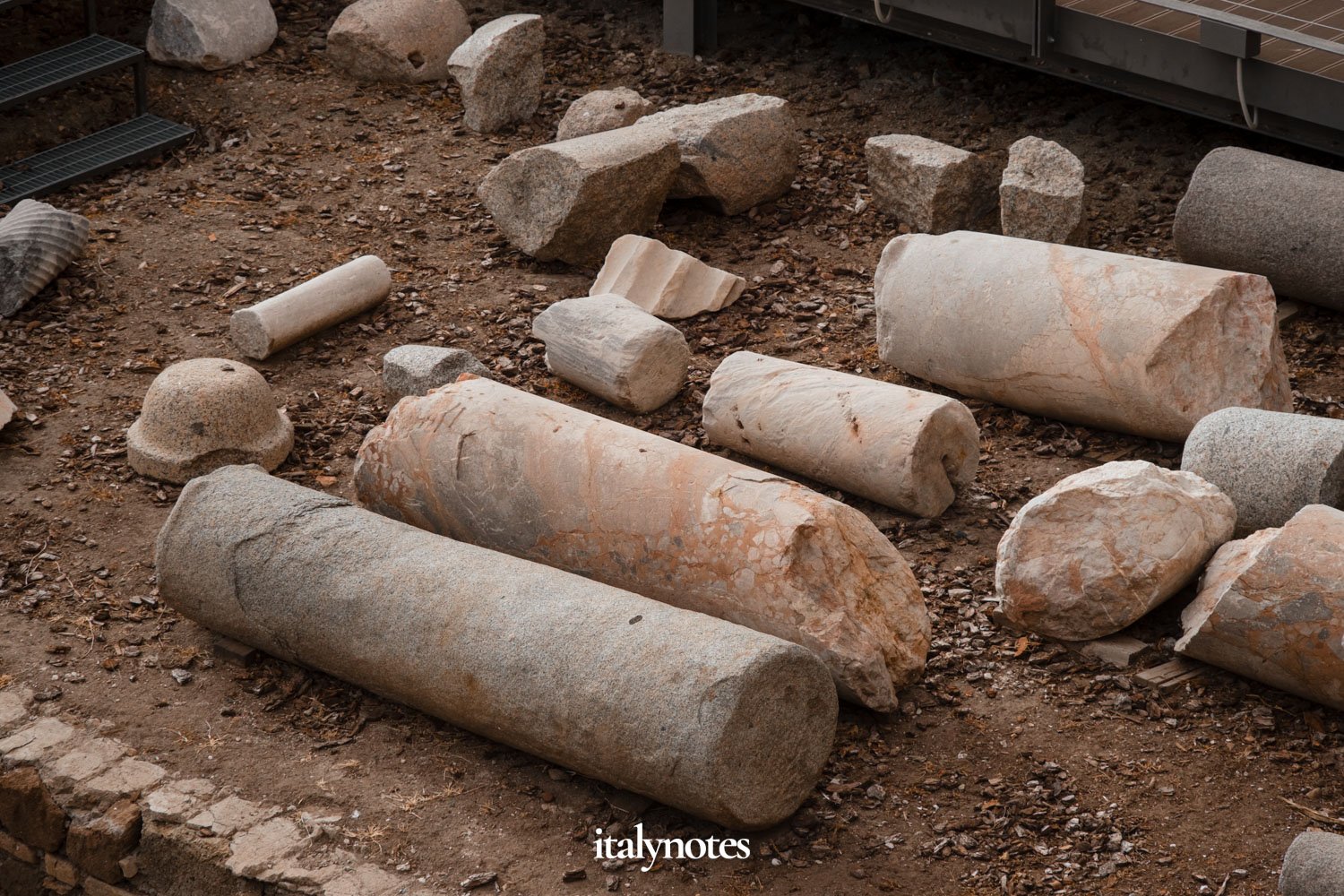
Several (random) fragments of pillars, unearthed during excavations.
Temple A
As the four temples have not yet been identified with certainty, they are designated by the first four letters of the alphabet.
The temple on the far right after entering the Area Sacra is Temple A. This temple was built in the 3rd century BC and is believed to be the Temple of Juturna, the goddess of fountains. It was erected on the behest of Gaius Lutatius Catulus after his victory against the Carthaginians in 241 BC.
The initial structure stood on a tuff podium with four columns along the front. In the subsequent centuries, however, many modifications were made. Perhaps the most significant change was the temple's transformation into a monastery (6th century AD) and later into a church (9th century AD), the apse of which is still present.

Close-up view of the remnants of Temple A and the apse of the church constructed above it in the 9th century AD.
Temple B
Set on a high podium, Temple B was built at the end of the 2nd century BC. Quintus Lutatius Catulus had the temple built after the Battle of Vercellae in 101 BC, which ended the war against the Cimbri. The temple's circular plan with six columns remaining sets it apart from the other three.
The temple was probably devoted to Fortuna Huiusce Diei (The Fortune of This Day). The colossal head, arm, and foot found during excavations belonged to a statue of the goddess herself. Today the excavated parts are kept in Centrale Montemartini.
Temple B underwent numerous transformations as well. After the disastrous fire in AD 80, it was transformed into what looks like a tholos, with the spaces between the columns closed by a brick wall.
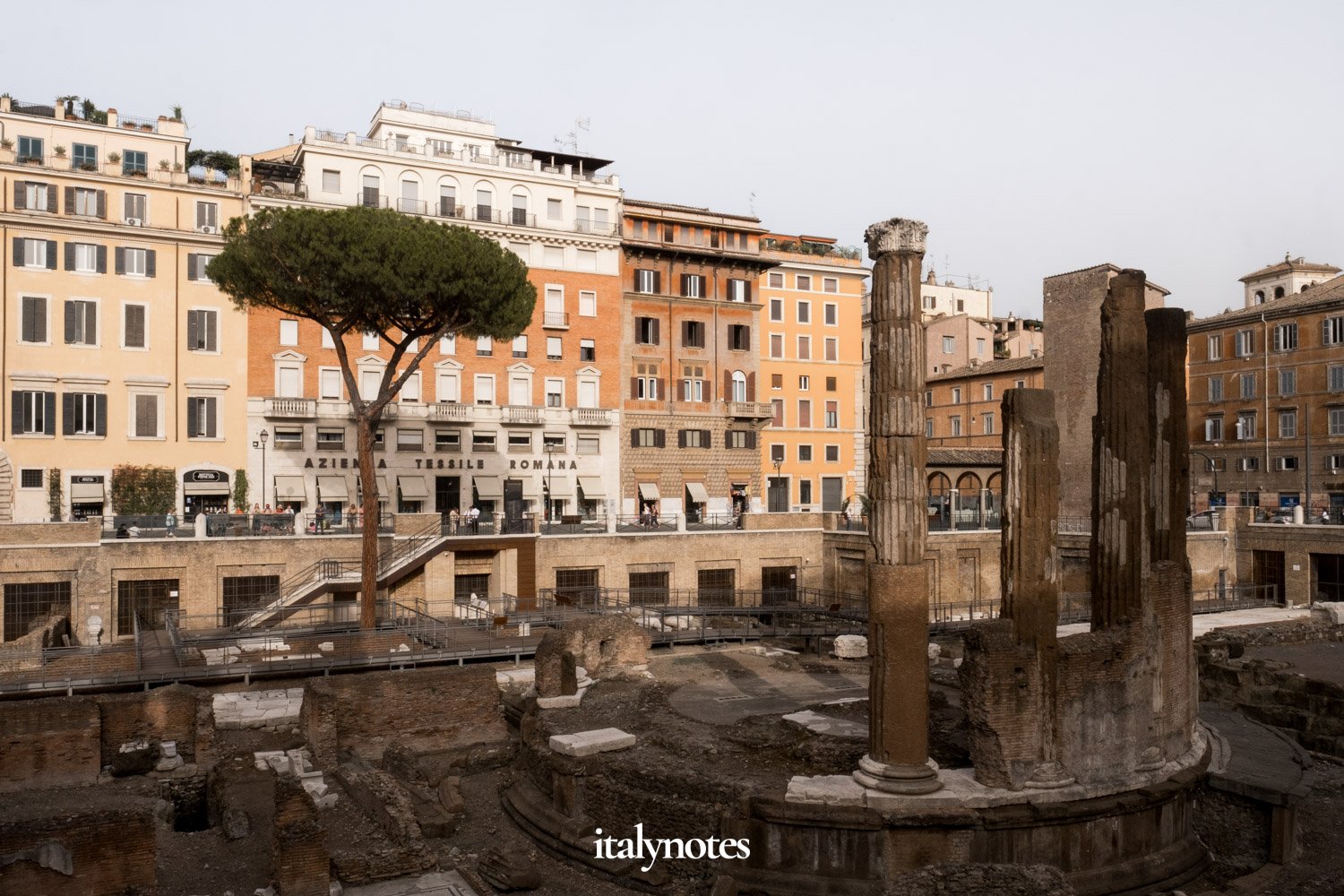
The rear view of Temple B as seen from Via di Torre Argentina, showcasing the circular floor plan and traces of the brick walls between the columns.
Temple C
Dating to the 3rd century BC, Temple C is the oldest of the four. It was most likely devoted to Feronia, the ancient goddess of fertility. The cult would have been introduced to Rome after the consul Maniu Curius Dentatus conquered the Sabines in 290 BC.
Under Domitian, after the fire in AD 80, the cella was restored with brick-lined walls and a mosaic floor. At the same time, a new travertine floor paving extending over the entire area was added.

Remains of the steps leading up to Temple C, with the travertine floor paving visible in front of them.
Temple D
Though only a fraction of Temple D is excavated (most of it is still covered by the street above), it is the largest of the four. It was constructed in the 2nd century BC and dedicated to the Nymphs or, according to other hypotheses, the Lares Permarini ('Lares' were guardian deities, and in this case, gods who protected sailors). Unfortunately, very little is known about the original building as it was enlarged and completely renovated at the end of the 1st century BC.
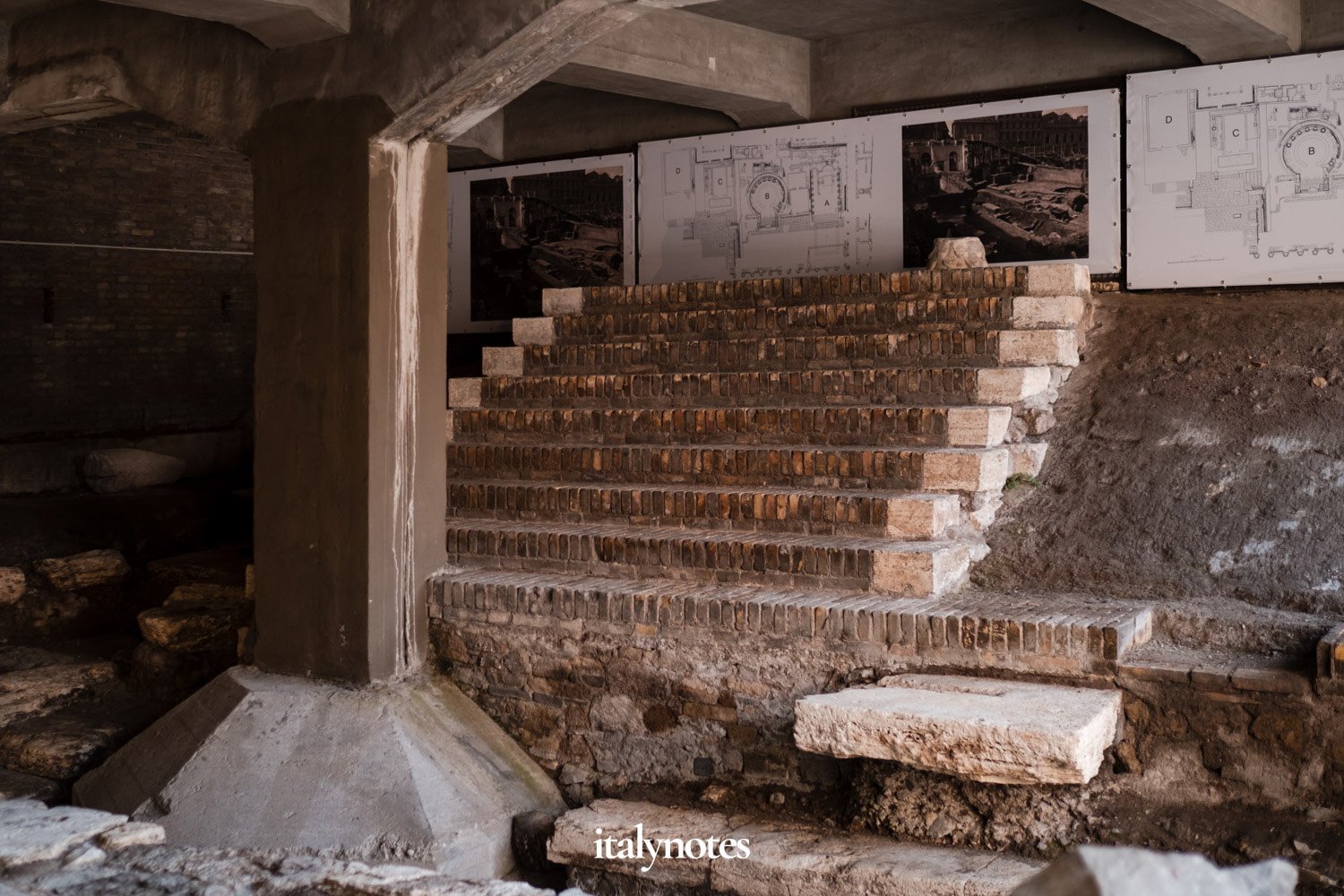
As you can see, only a fraction of Temple D is excavated.
Assassination of Julius Caesar
Now let's go back to temples B and C. Behind them, you can see the remains of an imposing base made of large tuff blocks. This base was part of the Curia of Pompey, a large rectangular hall where the Senate sporadically met. It was attached to a monumental complex with a theatre, the Temple of Venus Victorious, and a majestic portico. But though noteworthy, this is not what the Curia of Pompey is most famous (or infamous) for.
There were fears that Julius Caesar's unprecedented concentration of power during his dictatorship undermined the Roman Republic. This fear resulted in a conspiracy involving 60 to 70 senators led by Marcus Junius Brutus, Gaius Cassius Longinus, and Decimus Junius Brutus Albinus.

See that tree on the right? It is near to where Caesar was assassinated, or so they say.
On March 15th, 44 BC, the Senate met at the Curia of Pompey. As Caesar arrived and took his seat, the conspirators crowded around him. And within moments, he was attacked from all directions. Caesar attempted to fight back, but he tripped and fell. While lying defenseless on the lower steps of the portico, the senators continued stabbing him until he gave no more sign of life. Caesar was dead.
The autopsy report – the first post-mortem report in history – described that Caesar was stabbed 23 times. Still, only one of the wounds was fatal. Caesar's death was most likely caused by the amount of blood loss from his wounds.
Other findings
The Area Sacra di Largo Argentina also houses a new exhibition space. It is located below street level and follows a series of ancient pillars built by Emperor Domitianus after the fire in AD 80. The pillars once flanked a porticoed road that was perhaps part of the triumphal route in the Republican Age.

The new exhibition space houses several marble artifacts that were found during the excavations.
The exhibition contains several marble artifacts that were found during the excavations. Unfortunately, it's not certain whether the materials belong to the monuments in the area. Why? Well, during the Middle Ages, the area was called 'Calcarario.' It owed its name to the presence of a large number of lime kilns. Here pieces of ancient marble were baked to convert them into lime. Therefore, some artifacts may belong to other sites and were brought to Torre Argentina to be calcined.
Head of a colossal statue of a female deity (left) and funerary inscription of a father grieving the death of his young son (right), dating from the end of the 1st century AD.
Cat Sanctuary
Sheltered by the ancient ruins and fed by locals, many stray cats were drawn to the area after the excavations. This eventually led to the foundation of what might be Rome's most famous cat shelter.
The Torre Argentina Cat Sanctuary is located in Temple D. Here, volunteers take daily care of about 150 cats and offer sterilization and adoption programs. But despite this noble deed, the shelter faced closure when national archaeological officials demanded that the cat shelter be evicted from the ruins. Over 30,000 signatures were collected for petitions to preserve the Cat Sanctuary and keep it running. The Cat Sanctuary is open daily; pay them a visit if you want.
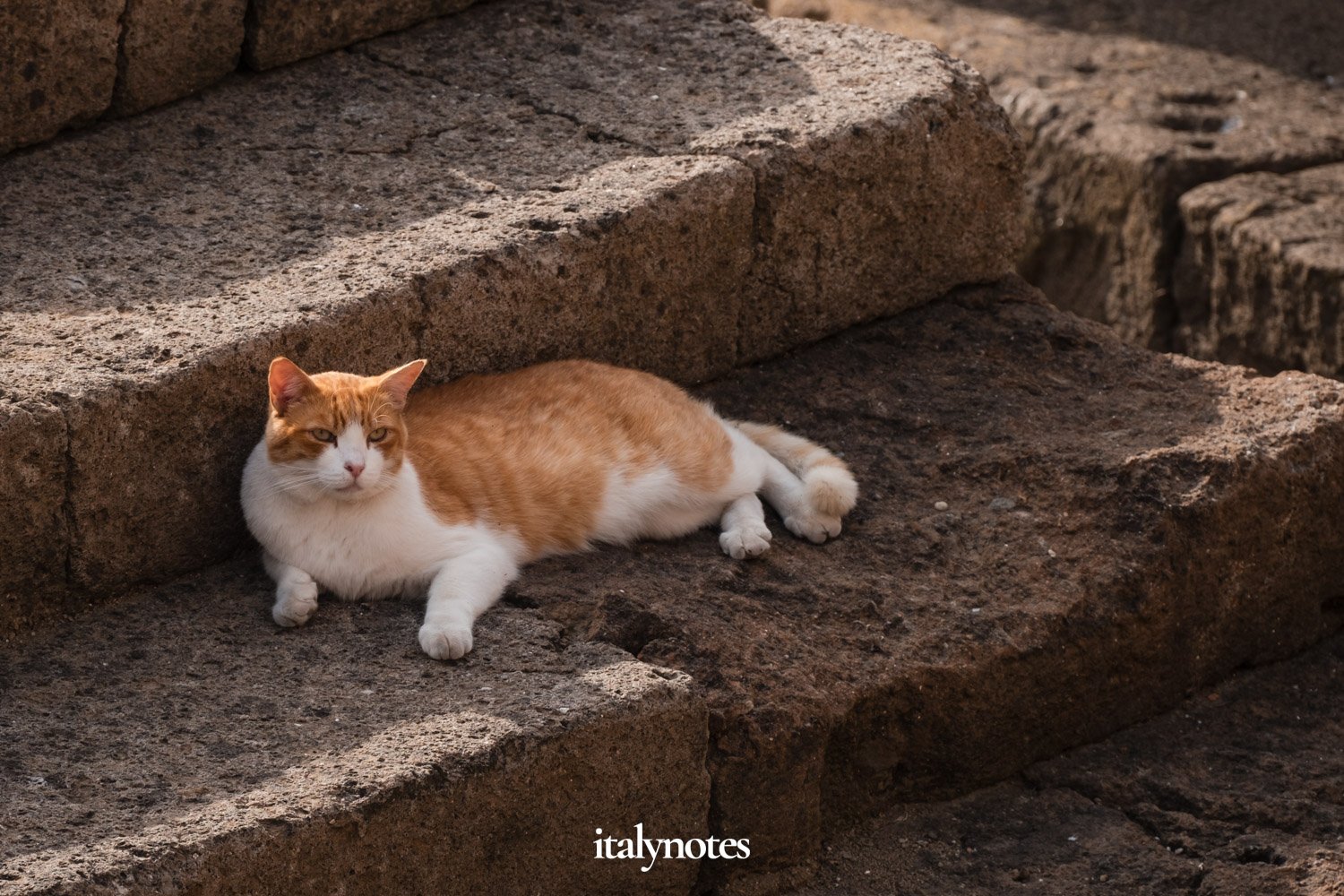
One of the stray cats resting in the shade on the steps of Temple C.
Discover the rest of Rome










